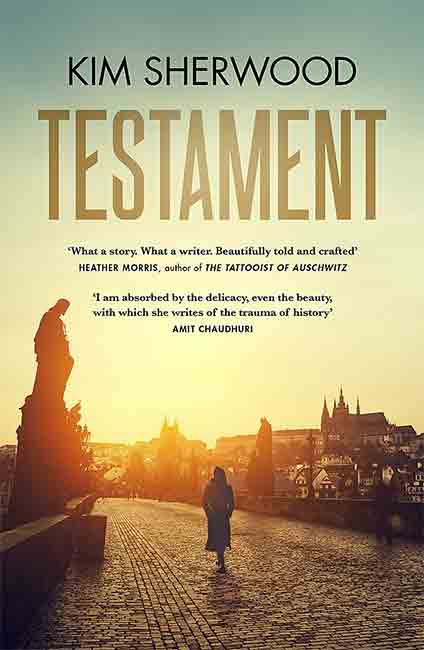
Testament, Kim Sherwood (£8.99, riverrun)
George Santayana’s quote ‘Those who cannot remember the past are condemned to repeat it’ has entered into common parlance, often in paraphrase and unattributed. My favourite version is Steve Turner’s, which is cleverly repeated several times throughout his poetry book Nice and Nasty:
HISTORY LESSON
History repeats itself.
Has to.
Nobody listens.
Nobody listening can of course be due to a kind of numbness to the same story being told in a familiar way over and over again. This can also lead to ideas of ownership, by individuals or communities who think a story belongs to them and only them. The holocaust is one such story (and please note the word story does not equate to fiction), and the current rise in xenophobia and anti-semitism is in many way due to people not paying attention to history.
In one of the essays in Singer on the Shore the author Gabriel Josipovici discusses the fact that the stories which make up what he calls communal memory need to be told anew, in different forms and voices, and cannot be ring-fenced or set in stone; retold stories are not static but are dynamic and alive. New versions do (or should) not distort, change or deny, but encourage people to listen and learn, to once more engage with stories they have heard before:
I would like to suggest that communal memory in traditional societies can be thought of first of all as dialogue. Maurice Halbwachs, the distinguished Jewish sociologist who was murdered by the Nazis in the last year of the war, divides the latter part of his book, Les cadres sociaux de la mémoire [On Collective Memory], into chapters on the family, religion and the realm of work. In each case, as he shows, what is important is the continual dialogue which is involved between parent and child, priest and parishioners, master and apprentice. Traditions are handed down by word of mouth, but not at all as one hands over a baton in a relay race, for what is passed on is inseparable from argument, discussion, meditation and practice. The child grows up hearing his parents and grandparents, his uncles and aunts, talking about earlier generations or distant members of the family of whom he has no personal knowledge; but he comes to know these people by means of the anecdotes he hears about them, the arguments his seniors get into concerning them, and the answers given to the questions he himself has. And when the time comes he in turn passes these on to his own children, joined now to anecdotes and arguments about his parents, grandparents, uncles and aunts he has himself known.
Kim Sherwood’s Testament is one such new telling, part of a continuing dialogue. It is new because it deals as much with the emotional inheritance of the holocaust and the ongoing confusion and hurt of second and third generation relatives as the concentration camps, ghettos, marches, train journeys and deaths. It deals with the narrator’s grief when her grandfather dies and her confusion as his past is slowly revealed. It is a dialogue between Eva and her grandfather, Eva and historians/archivists, Eva and documented and undocumented history, Eva and her parents, Eva and herself and, of course, Eva and the reader. It is also a dialogue between the present and past, the secular and the religious, the victim and the oppressor, the living and the dead.
Eva’s grandfather Silk is, or was, a famous artist who is pretty much estranged from Eva’s own parents, who are now separated and living abroad: her mother in Australia, her father in Europe. Eva has shared Silk’s house in London and cared for him in his final years. Her grief at his death is compounded by the discovery of a letter as she explores his painting studio, supposedly with the intention of starting to put his things in order. Suddenly a new history is hinted at and over the course of 450 pages, revealed.
For the reader this reveal is as much from a historical narrative set in World War 2 as Eva’s research, travel and contemplation. In Budapest and Berlin, she meets curators and strangers from her grandfather’s past; meanwhile, the reader travels into the ghetto and concentration camps, goes on forced marches and into exile, discovering Silk’s (who was then József) past. We are confronted not only with friendship, love, pain and basic survival, alongside Eva’s bewilderment, emotion and fear.
There is no happy ending to this book. Silk’s story may become clearer, but – like Eva – it is hard for the reader to come to terms with Silk’s disavowal of his own past, or to understand how it has – without even being acknowledged or recounted by him – emotionally and psychologically damaged his children and grandchildren. Eva has to grapple with the question of whether or not to make Silk’s past public, as part of an exhibition at the Berlin Jewish Museum; of whether to gift his story, along with his paintings, to others, despite only just having gained a knowledge and partial understanding of that story herself.
This novel is neither mawkish nor condescending, nor is it designed simply to provoke, inform or remind (though it does all three). It is a very personal, human retelling of a most inhuman story that we all-too-often neatly package up and label ‘the holocaust’, thus enabling ourselves to put it to one side. By unpacking history and peopling it with realistic actions, events and emotions, Sherwood allows readers to question for themselves the ongoing effects of genocide for not just survivors and their families but all of us. Just as Eva does, we can question ourselves as we are challenged to remember, to not repeat the past, and perhaps more importantly to not allow the past to be repeated.
Rupert Loydell
